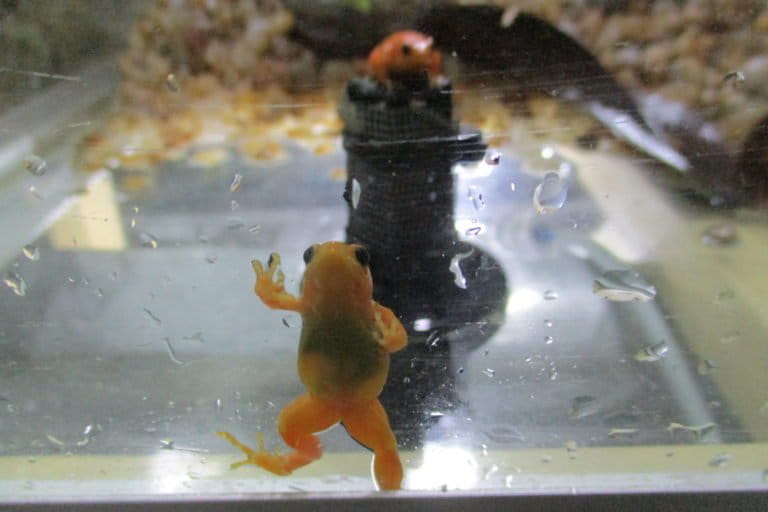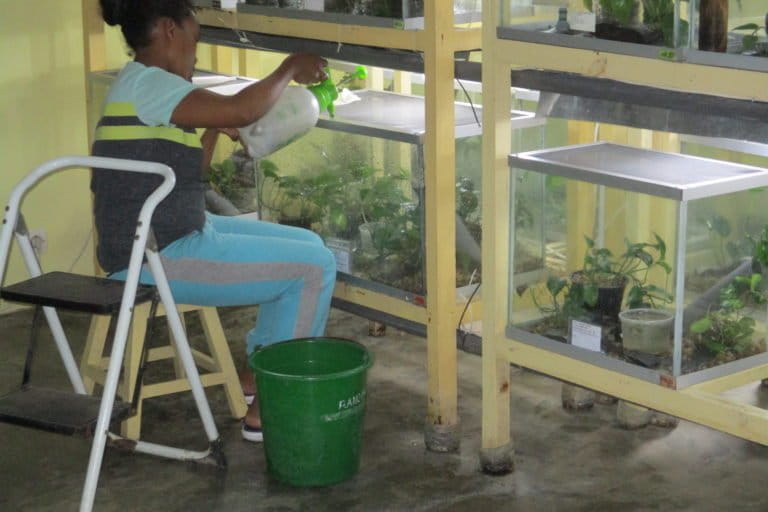- The critically endangered golden mantella frog (Mantella aurantiaca) lives exclusively in the eastern portion of Madagascar’s Central Highlands.
- The frog is threatened by habitat loss, brought on in part by the Ambatovy nickel and cobalt mine.
- A rescue plan designed by citizens and supported by Ambatovy has led to the development of techniques for raising and breeding the frog in captivity.
- Specimens raised in captivity were reintroduced into the wild in 2017, but studies examining their fate have yet to be released.
MANTADIA, Madagascar — In 2017, more than 1,500 golden mantella frogs hopped into breeding ponds near the Ambatovy nickel and cobalt mine in eastern Madagascar. Their reintroduction to the wild was part of a program to mitigate the mine’s environmental impact. The frogs’ release marked a milestone in an effort to raise and breed the species in captivity. Three years later, scientists and conservationists are awaiting the results of studies examining the success of the reintroduction effort.
The critically endangered golden mantella frog (Mantella aurantiaca) lives exclusively in the Moramanga area in the eastern part of Madagascar’s Central Highlands. The Mangabe forest, Torotorofotsy marsh (designated a wetland of international importance under the Ramsar Convention), and the Andriambondro Ambakoana forest, all protected areas, are hotspots for this amphibian. Torotorofotsy marsh is among the areas affected by Ambatovy’s mining activities, resulting in the need for conservation measures.

Ambatovy represents the largest foreign investment ever made in Madagascar, with around $8 billion in projected spending over at least 29 years. It has a production capacity of 60,000 metric tons of refined nickel and 5,600 metric tons of refined cobalt per year, as well as ammonium sulfate, from a deposit beneath 1,600 hectares (nearly 4,000 acres) of primary forest. Miners extract minerals at depths between 20 and 100 meters (66 and 328 feet), clearing areas rich in biodiversity.
The mining company is required to respect strict national and international rules regarding environmental protection and social engagement, in compliance with the Equator Principles, a risk management framework adopted by financial institutions, and the International Finance Corporation’s Performance Standards. “Ambatovy’s Environmental Management Program is characterized by the mitigation hierarchy process (avoidance of impacts, minimization, restoration, and compensation) and aims at creating no net loss but preferably a net gain in biodiversity,” the company’s website states.
Ambatovy has committed to restore the forest cleared to set up the mine and to finance conservation and development projects to compensate for its impacts. To protect certain species, Ambatovy agreed to exclude some areas from the mine footprint, and helped establish a new protected area in Ankerana, 70 kilometers (43 miles) northeast of the mine.
Scientists have also pointed to Ambatovy as responsible for introducing the toxic and invasive Asian toad (Duttaphrynus melanostictus) into the country. While the company has not acknowledged responsibility for introducing the toad, it has implemented toad containment efforts, according to previous Mongabay reporting. However, scientists believe the Asian toad is now too numerous to eradicate, threatening a broad suite of Malagasy wildlife.
Toby Sahona frog breeding center
Habitat destruction, including by Ambatovy, are among the threats to the golden mantella. The chytrid infection, which has devastated frogs around the globe and whose presence in Madagascar a 2015 study documented, presents an even more serious danger. This fungus could threaten the survival of all the country’s diverse frog species, and the golden mantella is no exception.
“We sought to transfer animals from their natural habitat to an artificial habitat,” said Ambatovy biodiversity expert Gilbert Rakotondratsimba, who oversees the reintroduction project for the company. “We thought that in case of massive extinction of species, conservation ex situ or in zoos should be a last resort.”
Association Mitsinjo, a local community group involved in tourism, research, conservation and education activities, began working with Ambatovy on the golden mantella captive-breeding project in 2012. The group had previously collaborated with the company on efforts to conserve other species, including lemurs and birds. In 2011, in response to the threat of chytrid, Mitsinjo had helped establish a frog conservation and breeding center named Toby Sahona in a 700-hectare (1,730-acre) forestry station belonging to the Malagasy government that is next to Andasibe-Mantadia National Park, one of the country’s flagship protected areas. The environment ministry and the IUCN’s Amphibian Specialist Group inspect the Toby Sahona center every three months, and Ambatovy inspects it monthly.

Workers systematically screen areas Ambatovy has slated for clearing, looking for golden mantellas, starting years before the clearing takes place. They transfer any frogs they find in breeding ponds to other potential breeding ponds, called receiving ponds. These screenings take place every year until the researchers are sure that almost no golden mantellas remain in the targeted ponds.
“The breeding season from October to February is the best period for the screenings. M. aurantiaca tends to dwell on land; populations live in the forest. During the breeding season, they leave the group to return to the BPs,” said Gilbert Rakotondratsimba, referring to breeding ponds. The 162 specimens entrusted to Mitsinjo in 2012 came from around 10 of the 38 breeding ponds identified around the Ambatovy mining site.
The group adapted well to captivity, and their multiplication surpassed expectations. “We didn’t expect such dynamism with ex situ breeding,” said Nirhy Rabibisoa, an amphibian expert at the University of Mahajanga who helped establish Toby Sahona. The cross-breeding of individuals from different breeding ponds, to mitigate the possibility of inbreeding, resulted in more than 1,200 healthy frogs being born in 2012–2013 — the F1 generation in genetics jargon. This generation gave rise to subsequent cohorts released together in April 2017.

Learning frog cuisine
The project has contributed to knowledge about how to care for the golden mantella and its breeding habits, as Nirhy Rabibisoa and colleagues documented in a 2015 paper. Success in breeding and repopulating the species hinges on fertility — and fertility hinges on good care. “The development of eggs carried by females mostly depends on the quality of food and environmental conditions,” Justin Claude Rakotoarisoa, Association Mitsinjo founding member and manager of Toby Sahona, told Mongabay.
But ensuring an optimal diet and environment is easier said than done. Toby Sahona staff attend to factors that may seem insignificant, such as maintaining a low number of frogs per enclosure to avoid stressing the animals.
Feeding the frogs requires great self-sacrifice and skill. Most of the work involves preparing meals. Since insects such as fruit flies, grasshoppers and springtails are an integral part of the amphibians’ diet, raising live food is essential. Insects also need specific conditions to survive. Staff invented simple devices to regulate the incubators’ temperatures according to the species’ requirements.
Staff use readily available foods to produce insect feed. For example, a mixture of potatoes, bananas, sugar, milk and yeast makes a very good meal for fruit flies. But each type of insect has its own diet. When grasshoppers struggle to bite into a piece of carrot, cabbage or zucchini, the humans do their best to find solutions.
But live insects alone are insufficient for a complete frog diet. Frogs are fond of nutritional supplements, such as vitamins, which caretakers feed to the insects or mix with them.
The quantity, variety and frequency of meals are also important. Since golden mantellas are quite small, at most 2.5 centimeters (1 inch) long, they should ideally be fed five to 10 tiny baby grasshoppers. Overeating is bad for them. During the breeding season, meals are limited to three times a week: every Monday, Thursday and Saturday. Intake is reduced during hibernation.
Still, there is some guess work. “Nobody knows the exact number of insects eaten by a frog in the wild, whatever its stage of development. It is therefore important for us to produce as much food as possible in order to vary their diet,” Justin Claude Rakotoarisoa said.

Moreover, tadpoles have different dietary requirements than adults. Staff feed them spirulina bought in Moramanga, the nearest town, that they mix with shrimp powder. “We are adapting. We don’t have their specific food; it is only available in the United States. The center has a few boxes thanks to donations from American visitors,” Justin Claude Rakotoarisoa said.
Moreover, tadpoles have different dietary requirements than adults. Staff feed them spirulina bought in Moramanga, the nearest town, that they mix with shrimp powder. “We are adapting. We don’t have their specific food; it is only available in the United States. The center has a few boxes thanks to donations from American visitors,” Justin Claude Rakotoarisoa said.
Reintroduction into the wild
One early morning in April 2017, shortly after the end of the breeding season and on the eve of hibernation, the time had come to transport golden mantellas to the release sites, which had been thoroughly inspected before D-Day. Staff had color-coded all of the animals, both frogs and tadpoles, so they could be monitored afterward.
“Personally, I was afraid they might die during the journey, which lasted two hours. Fortunately, there was only one victim,” Gilbert Rakotondratsimba recalled. The release went off without a hitch.
The results of studies evaluating the survival of the reintroduced frogs and the progress of the reintroduction effort by scientists and students from the University of Antananarivo and the University of Mahajanga, as well as by experts from partner organizations such as the NGO Madagasikara Voakajy, have not yet been published. However, both Rakotondratsimba and Rabibisoa said they believed the effort was successful. “The released frogs were able to survive. Of course, some of them died, but only a small number,” Rakotondratsimba said.
“With mammals or fish, for example, if you translocated a batch of 100 individuals, you would not be able to find them all at the release site. You could find only 10 at most. This is because they move around frequently,” he said. “It is even more difficult with frogs. We do not know their real way of life in nature.” He added that a team from Madagasikara Voakajy revisited the translocation area and found that the golden mantellas had dispersed, some more than 2 kilometers (1.2 miles) from the ponds where they were released.

“It was a great first, especially among amphibians. With this momentum, Ambatovy will continue to support the translocation program for M. aurantiaca, an endemic and endangered species, for the next three to five years,” the mining company said in a press release in October 2019, soon after a workshop at which it presented an assessment of the 2017 reintroduction to government officials.
The continuation of the project should allow scientists to learn more about the species’ life, both in nature and in captivity, and hopefully give the little golden frogs a shot at surviving.
Clarification 7/15/20: The story was updated to describe the introduction of the Asian toad (Duttaphrynus melanostictus) as a possible environmental impact of the Ambatovy mine.
A version of this story was first published here on Mongabay’s French site on March 31, 2020. The English translation was edited for clarity by Rebecca Kessler.
